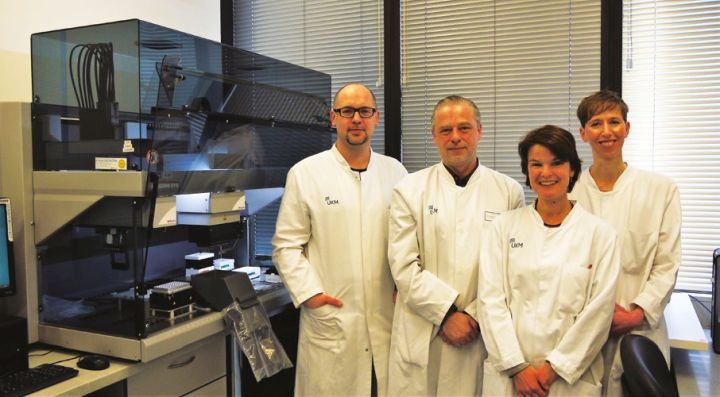Tecan uses cookies to improve our website. By continuing to browse our website, you accept our cookie policy.
Tecan uses cookies to improve our website. By continuing to browse our website, you accept our cookie policy.

Automation is helping the University Hospital Münster to streamline its molecular diagnostics workflows, increasing throughput for Sanger sequencing and NGS library preparation.
The University Hospital Münster (UKM) is one of Germany’s leading hospitals, providing state-of-the-art healthcare to national and international patients. It is also home to the Center for Laboratory Medicine, which provides core laboratory services – including clinical chemistry, hematology, endocrinology, virology, immunology and therapeutic drug monitoring – to the hospital and its external clients, typically performing around 10,000 analyses per day. The laboratory’s molecular diagnostics department uses Sanger sequencing with capillary electrophoresis for routine diagnostics, as well as performing next generation sequencing (NGS) in collaboration with other UKM groups. Automation is the key to standardizing and streamlining the department’s workflows, as Dr Hartmut Schmidt, Head of Molecular Diagnostics, explained: “One of our department’s main roles is to perform routine Sanger sequencing on samples from several different groups. We can carry out as many as 2,000 analyses per day, occasionally even more; the human genetics department, for example, sometimes submits nine plates for processing on one day, which is around 900 samples from just one group.”
Hartmut continued: “One of the major challenges in Sanger sequencing is the removal of unincorporated dye terminators. In the past, we did this manually, but it was a slow process that required three hours of preparation before sequencing could begin. Not only was this time consuming, but it restricted our flexibility in the lab, and so we turned to automation.”
The laboratory chose a Freedom EVO® 150 workstation equipped with a MultiChannel Arm™ 96 to help with the dye removal. This set-up allows one plate to be incubated while the workstation performs the necessary pipetting steps to prepare the next, which is an important feature to meet the lab’s testing demands. “Automation of the clean-up procedure has improved our throughput – we can do up to six runs in one hour – allowing us to handle a greater number of samples and report the results more quickly,” Hartmut commented.

Left to right: Mathias Isakiewitsch, Hartmut Schmidt, Kathrin Meyer zu Himmern and Kathrin Haar with the Freedom EVO workstation
“As an accredited laboratory, we take great care to ensure the quality and reliability of our sequencing results, and thoroughly compared our old method with the automated protocol before it was implemented. One of the big advantages of automating the workflow is the elimination of dye blobs – artefacts that interfere with the sequencing analysis, making it harder to identify the correct base pairs – enabling faster analysis of the data. We have also been able to overcome the issue of variations in signal strength. The samples sent to us for analysis by other groups vary in signal intensity from low to medium to high; if the signal is too high, the analysis may fail and have to be repeated. We use a magnetic beadbased method of purification, and have been able to implement a signal cut-off value by using the Freedom EVO to add a defined amount of beads. This allows us to remove any unincorporated dye terminators, maintaining the signal intensity within a suitable range and reducing the number of repeat sample analyses, something we were unable to do with our previous filtration-based purification process.”
"One of the big advantages of automating the workflow is the elimination of dye blobs… enabling faster analysis of the data."
In addition to Sanger sequencing, the molecular diagnostics department performs automated NGS library preparation for a number of other UKM groups. This work is performed on a Freedom EVO NGS workstation, which is available with a number of verified protocols – developed in collaboration with the vendors – for different chemistries. Tecan application specialists worked with the UKM team to implement and evaluate these protocols for the chemistries currently used by the human genetics and neurogenetics departments. Hartmut added: “Now that the evaluation is complete, we can process these varying chemistries just by using different automated methods; it’s a really good system, and one that can evolve to accommodate other chemistries in the future as our needs change.”
In a busy department, staff only have a limited amount of time to spend learning a new technique, and one of the big advantages of the Tecan systems for UKM is that they are easy to use. The company’s service engineer helped UKM staff to write TouchTools™ protocols that take operators through the workflows step by step, using photographs integrated into each program to display on screen exactly where the labware, samples and reagents should be placed on the workdeck. “It is a really useful feature that makes the platform very straightforward to use,” Hartmut concluded.
To find out more about Tecan’s genomics solutions, visit www.tecan.com/freedomevo
To learn more about UKM’s Center for Laboratory Medicine, go to www.ukm.de
Keywords: